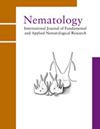突尼斯棘球蛾与三角棘球蛾,1924的形态与分子比较分析(横纹肌目,头足科)
IF 1.2
4区 生物学
Q2 ZOOLOGY
引用次数: 5
摘要
从突尼斯土壤中分离到4个棘球线虫居群。基于形态学和形态计量学数据,将TC9和hho两个种群鉴定为三角蠓,TC7和K18g两个种群鉴定为博登海梅氏蠓。三角棘球蛾与其近缘种的区别在于其高唇问题,末端呈弧形,子宫后囊不明显,外侧切口5个;而波登海默棘球蛾与其他棘球蛾的区别在于其低而圆的唇问题,明显的子宫后囊,5个外侧切口,外阴经常有阴道塞。本研究中报道的三角角瓢虫和波登海梅氏瓢虫通过唇问题的形状(高,远端较短,低而圆),子宫后囊(不明显与明显),生殖系统相对于肠道的位置(左侧与右侧),带阴道塞的外阴(存在与不存在)和一些形态特征(如体长)来区分。此外,这些物种还利用28S rRNA基因的D2-D3区域、18S rRNA基因、ITS rRNA基因和线粒体细胞色素c氧化酶亚基I (mtCO1)基因的序列进行了分子表征。使用核糖体RNA基因序列的系统发育树可以清楚地分离出“Maximus”类群的物种,但这些序列在其他几个Acrobeloides物种中似乎是相同的,因此不太可能作为Acrobeloides属物种水平分子鉴定的分子标记。两个三角拟南蝽居群的mtCO1基因序列与A. varus和A. nanus的差异分别为58和64个核苷酸碱基,表明mtCO1基因序列比核rRNA基因序列具有更大的系统发育分辨力,该基因标记可以区分近缘种。本文章由计算机程序翻译,如有差异,请以英文原文为准。
Comparative morphological and molecular analyses of Acrobeloides bodenheimeri and A. tricornis Cobb, 1924 (Rhabditida, Cephalobidae) from Tunisia
Four populations of Acrobeloides nematodes were isolated from Tunisian soils. Based on morphological and morphometric data, two populations, TC9 and HWO, were identified as A. tricornis and the other two, TC7 and K18g, as A. bodenheimeri. Acrobeloides tricornis is distinguished from its closely related species by its high labial probolae with arcuate termini, inconspicuous post-uterine sac, and five lateral incisures, while A. bodenheimeri is distinguished from other acrobeloids by having a low and rounded labial probolae, distinct post-uterine sac, five lateral incisures, and vulva frequently with vaginal plug. The A. tricornis and A. bodenheimeri reported in this study are distinguished by the shape of labial probolae (high with acute distal part vs low and rounded), post-uterine sac (inconspicuous vs distinct), position of the reproductive system with respect to the intestine (sinistral vs dextral), vulva with vaginal plug (present vs absent) and some morphometric characters (such as body length). Further, these species were also molecularly characterised using the sequences of the D2-D3 region of the 28S rRNA gene, the 18S rRNA gene, the ITS rRNA gene, and of the mitochondrial cytochrome c oxidase subunit I (mtCO1) gene. Phylogenetic trees using ribosomal RNA gene sequences clearly separate species of the ‘Maximus’ group, but these sequences appear to be identical in several other Acrobeloides species, and thus are unlikely to be useful as molecular markers for species-level molecular identification in the genus Acrobeloides. The mtCO1 gene sequences of two A. tricornis populations differ in 58 and 64 nucleotide bases from A. varius and A. nanus, respectively, indicating that the mtCO1 gene sequences have greater phylogenetic resolving power than nuclear rRNA gene sequences, and that this gene marker can differentiate closely related species in the genus Acrobeloides.
求助全文
通过发布文献求助,成功后即可免费获取论文全文。
去求助
来源期刊

Nematology
生物-动物学
CiteScore
2.60
自引率
33.30%
发文量
67
审稿时长
3 months
期刊介绍:
Nematology is an international journal for the publication of all aspects of nematological research (with the exception of vertebrate parasitology), from molecular biology to field studies. Papers on nematode parasites of arthropods, and on soil free-living nematodes, and on interactions of these and other organisms, are particularly welcome. Research on fresh water and marine nematodes is also considered when the observations are of more general interest.
Nematology publishes full research papers, short communications, Forum articles (which permit an author to express a view on current or fundamental subjects), perspectives on nematology, and reviews of books and other media.
 求助内容:
求助内容: 应助结果提醒方式:
应助结果提醒方式:


